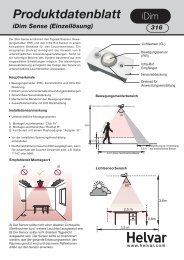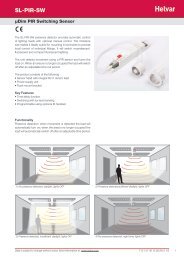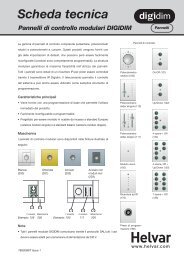THE CHAMPALIMAUD CENTRE FOR THE UNKNOWN - Helvar
THE CHAMPALIMAUD CENTRE FOR THE UNKNOWN - Helvar
THE CHAMPALIMAUD CENTRE FOR THE UNKNOWN - Helvar
You also want an ePaper? Increase the reach of your titles
YUMPU automatically turns print PDFs into web optimized ePapers that Google loves.
Text: Harriet Harsto / <strong>Helvar</strong> & João Fontes / JFS<br />
Pictures: José Campos, ARQF Consultores de Fotografia<br />
<strong>THE</strong> <strong>CHAMPALIMAUD</strong> <strong>CENTRE</strong><br />
<strong>FOR</strong> <strong>THE</strong> <strong>UNKNOWN</strong><br />
On October 5 th 2010 the Champalimaud Foundation inaugurated a state-of-the-art<br />
research facility, an important step in its objective of developing biomedical research<br />
activities in Portugal. The Champalimaud Centre for the Unknown was designed<br />
by world-renowned Indian architect Charles Correa, who received the prestigious<br />
Royal Gold Medal of the Royal Institute of British Architects in 1984.<br />
DISCOVERING <strong>THE</strong> <strong>UNKNOWN</strong><br />
The Champalimaud Centre for the Unknown is a centre for multidisciplinary research with<br />
optimal conditions to attract and retain the best academics, researchers and medical<br />
doctors from 20 different countries in the fields of molecular biology, genetics, immunology,<br />
oncology, neurosciences, and behavioural psychology. The new facilities for basic and<br />
clinical research and for teaching will support front-line research in its post-graduate and<br />
doctorate programs and research into the diagnosis and treatment of cancer patients.<br />
The Champalimaud Centre for the Unknown is located in a beautiful site of 60,000 m 2 in<br />
an exclusive area of Lisbon, on the waterfront of Pedrouços, near the magnificent Tower<br />
of Belém. This is where the river Tagus meets the Atlantic Ocean; the great Portuguese<br />
explorers sailed from here to discover the “unknown” in the 15 th and 16 th centuries. Inspired<br />
by this distinctive heritage, the Champalimaud Centre for the Unknown is a link between<br />
those epic voyages of yesteryear and the exciting scientific discoveries of the future.<br />
In recognition of the site’s historical significance, and of people’s enduring fascination with<br />
the oceans, the Centre allows the public free access to the waterfront, through the wide<br />
landscaped areas around its buildings.<br />
2 / 2011 •<br />
News 5
6<br />
A PUBLIC CAMPUS<br />
The Champalimaud project aims to foster and celebrate<br />
scientific excellence and discoveries whilst providing an<br />
inspirational space for the general public to enjoy. The<br />
Centre comprises two main buildings and a large public<br />
area. Building A houses the diagnostic and treatment<br />
units and the basic research laboratories. Building B<br />
includes the auditorium, the exhibition area, a restaurant,<br />
and the offices of the Champalimaud Foundation. The<br />
offices are connected to building A by an elegant glass<br />
bridge. As well as the gardens, the public areas feature<br />
an open air amphitheatre facing the river.<br />
A 125 metre long pedestrian pathway leads diagonally<br />
across the site, towards the open seas. As the pathway<br />
is on an incline, when walking uphill the sky is all you<br />
see on the horizon. At the top of the ramp there are<br />
two stone monoliths from a local quarry. At the highest<br />
point of the path, you see a large body of water, which<br />
appears to connect to the ocean beyond. In the centre<br />
of this pool, just below the surface, is an stainless steel<br />
oval object, slightly convex so that it reflects the blue<br />
sky and the passing clouds above; it could represent<br />
many parts of the adventures encountered on voyages<br />
of discovery - the back of a turtle, a tropical island, even<br />
a treasure chest.<br />
News • 2 / 2011<br />
SITE-SPECIFIC APPROACH TO<br />
SUSTAINABILITY<br />
The architecture is not the only element of the research<br />
centre to feature state-of-the-art design. A high tech<br />
Building Management System allows integration of<br />
several different environment-control solutions. For<br />
example, the proximity to the Tagus River allows having<br />
a geothermal heat-sink for temperature control, which is<br />
further controlled by the massive rain forest garden in the<br />
main building.<br />
Thanks to its world-class control and monitoring<br />
capabilities, and user-friendly functionality, a <strong>Helvar</strong><br />
Router System is used for lighting in all areas of the Centre<br />
and also controls all the blinds inside the buildings.<br />
The <strong>Helvar</strong> NET structure enables Ethernet 0/1<br />
communication between third party BMS systems and<br />
the <strong>Helvar</strong> Router system. The system is based on a<br />
structured Ethernet network that can control almost 1800<br />
DALI addresses, 3528 S-DIM addresses and over 7000<br />
DMX addresses. The system is currently running at 70 %<br />
capacity, which allows for future expansion projects.<br />
The <strong>Helvar</strong> Router System copes easily with the vast<br />
number of different light loads and partition walls.
The HVAC system uses information from the <strong>Helvar</strong><br />
Router system to control the activation and levels of the<br />
air-conditioning and ventilation in 80 % of the buildings.<br />
The Router system provides highly accurate real-time<br />
information to the HVAC system based on presence<br />
detection and monitoring of load levels. The <strong>Helvar</strong><br />
system also communicates with other systems such<br />
as AV, Access control, and Fire and Emergency Alarm<br />
systems. With their built-in astronomical clock, and<br />
based on geographical coordinates, the <strong>Helvar</strong> Routers<br />
automatically schedule lighting levels in many areas.<br />
<strong>Helvar</strong> modular panels and TouchPanels, as well as<br />
touch screens with <strong>Helvar</strong> TouchStudio Software, are<br />
used to control equipment in individual rooms or areas.<br />
The Champalimaud Centre for the Unknown will<br />
support the Foundation’s goals by providing research<br />
facilities that stimulate creativity and interaction within a<br />
compassionate and comfortable environment for patients<br />
and their families. The high-performance buildings<br />
employ optimal energy and resource management while<br />
celebrating the unique site on which it is located.<br />
SYSTEM FACTS<br />
The new facilities for basic and clinical<br />
research and for teaching will support<br />
front-line research in post-graduate and<br />
doctorate programs and research into the<br />
diagnosis and treatment of cancer patients.<br />
300 x EL-iDim DALI Ballasts<br />
14 x 920 IMAGINE Router<br />
54 x 474 DIGIDIM 4-Channel Ballast Controller<br />
22 x 452 DIGIDIM 1000W Universal Dimmers<br />
116 x 498 DIGIDIM 8-channel relay units<br />
41 x 490 DIGIDIM 2-channel blind controller<br />
182 x DIGIDIM Modular Push Button Panels<br />
7 x 924 TouchPanels<br />
16 x 8” Ethernet Touch Panels with <strong>Helvar</strong><br />
TouchStudio Software<br />
<strong>Helvar</strong> Designer software<br />
Lighting Control System: JFS<br />
Electrical & Lighting Consultant:<br />
António Almeida, COPRENG ENGINEERING<br />
Lighting Design: DPA Lighting Consultants<br />
Electrical contractors: J.J. TOMÉ & SOTÉCNICA<br />
Electrical cabinets: JFS & TURKAMPRE<br />
2 / 2011 •<br />
News 7
8<br />
<strong>THE</strong> <strong>CHAMPALIMAUD</strong><br />
FOUNDATION<br />
The Champalimaud Foundation, based in Lisbon, Portugal, was created at<br />
the bequest of the late Portuguese industrialist and entrepreneur, António de<br />
Sommer Champalimaud. At the end of 2004 it was officially incorporated as<br />
the Anna de Sommer Champalimaud and Dr. Carlos Montez Champalimaud<br />
Foundation, in honour of the benefactor’s parents. As stipulated by António<br />
Champalimaud prior to his death, Leonor Beleza, former Portuguese Minister<br />
of Health, is the Foundation’s President.<br />
The Champalimaud Foundation supports individual researchers and research<br />
teams working at the cutting edge of biomedical science. It aims to stimulate<br />
novel theoretical and practical methodologies by utilising the experience of<br />
both research scientists and medical practitioners.<br />
Through a detailed program of research and clinical support the Foundation<br />
strives to make significant scientific progress, particularly in the fields<br />
of cancer research and neuroscience. However, it is not enough to make<br />
short-term gains and it is essential that this work can be continued by future<br />
generations. The Foundation has therefore devised a number of objectives<br />
designed to promote scientific activity both now and for many years to come.<br />
The majority of the Foundation’s work takes place at the Champalimaud<br />
Centre for the Unknown, with a specific focus on neuroscience research,<br />
translational cancer research, and clinical practice. In this way, the Foundation<br />
aims to make significant advances in the biomedical sciences. Translational<br />
research is defined as scientific study that begins in the laboratory before<br />
progressing to the clinical arena, or patient’s “bedside”. In particular, priority<br />
will be given to research that will contribute to the improvement of the health<br />
and well-being of people worldwide.<br />
News • 2 / 2011<br />
The tropical garden is<br />
designed for patients and their<br />
families to be able to spend<br />
the often long hours required<br />
in such treatment in a warm<br />
and humane space.

















